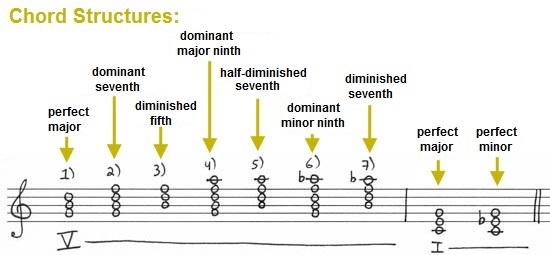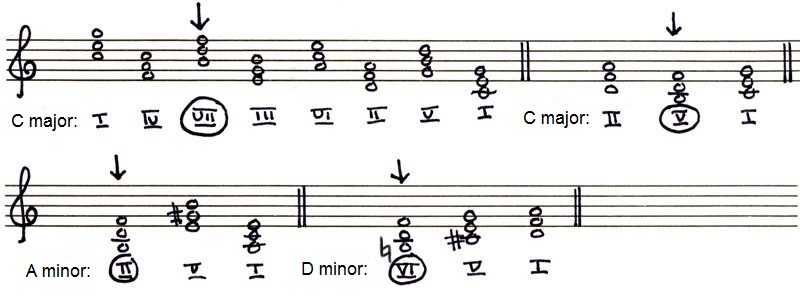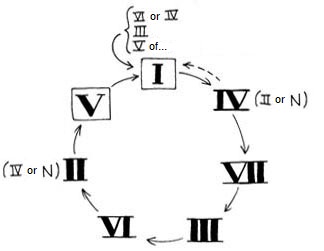1. THE GENERATIVE PAIR
From
the outset, we must agree on a generative pair, specifically the couple
V – I, which forms the essential gravitational force of the entire
tonal system. This pair alone, due to the manner in which it has been
employed by the tonal composers, is able to obtain for
the listener a feeling of accomplishment, plenitude, finality, and
absolute
stability in an art of movement whose essence is defined in terms of
tension and release. In fact, tonal listening itself searches for and
finds its very meaning through this relationship. However, in what
exactly does it consist and in what manner, concretely, is it realized?
Figure 4


From the figure
above, we may observe:
- that the role of the dominant
may be filled by at least seven distinct chordal structures, each of
which can also appear with the 5th raised or lowered by a semitone (see
the three augmented
sixth* chords), and some of which omit the
explicit root (tacit root for structures 3, 5, and 7). Here we must
acknowledge that the prevalence of the dominant-tonic pairing results
entirely from the attraction of the function V to the function I, an
attraction caused by the inherent presence of a tritone (augmented
fourth or diminished fifth) in the function V which provides a
veritable explosive charge that will be absorbed into the function I:
Figure 5

We also acknowledge that the first
of the seven structures capable of taking on the role
of a dominant (the major chord), undeniably possesses reduced tension since it is deprived of
the 7th and therefore, the presence of the tritone; what remains is
the attraction of the leading tone (7th degree) to the tonic (1st
degree).
- that only two chord structures
are able to take on the role of a tonic: the major chord and the minor
chord, either of which, on occasion (in the case of an inconclusive
event), may include an added 7th.
- that a relationship of a
descending perfect fifth exists between the (real) roots of the two
functions involved
- that this summary excludes any
chords resulting from ornamental notes such as:
Figure 6

- that for each chord it is
important to distinguish its structure (i.e. the
chord
itself: for example, a dominant seventh structure) from its function (i.e.the chord situated in the
harmonic discourse: for example, a chord could
take the role of the function V or of a different harmonic function, or
it could exist as a strictly ornamental function). From this
perspective,

Thus, a diminished fifth chord structure (such as B - D - F) could take on various harmonic functions, depending on the context:
Figure 7

At this point, the reader may
refer to the table titled nomenclature
of the classification of chords in the tonal system and of their most
frequent corresponding functions in the harmonic discourse from Bach to
Wagner*
Finally, before continuing on to the next section, it is
necessary to introduce the Neapolitan chord in order to explain the
presence of the "N" symbol which has already appeared in the circle of fifths of functions:
Figure 8

